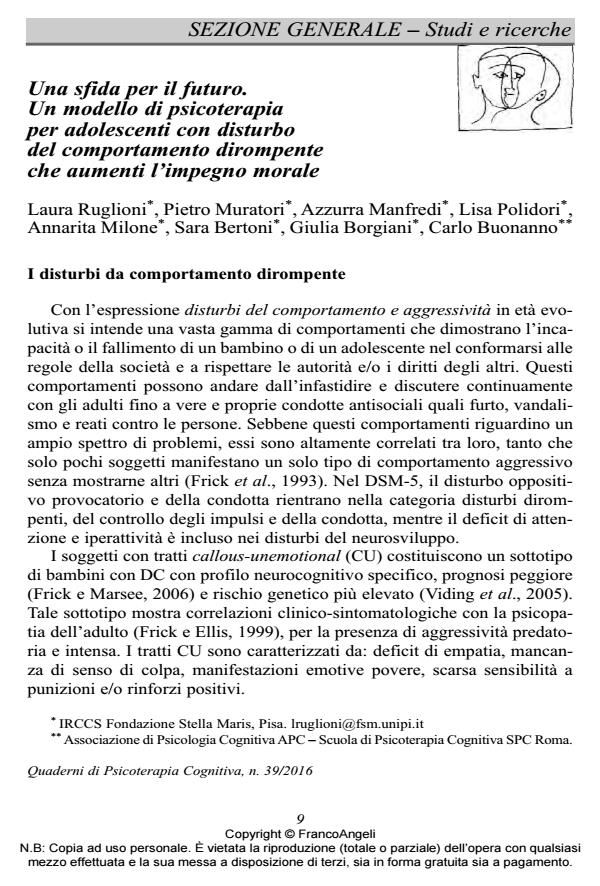Una sfida per il futuro. Un modello di psicoterapia per adolescenti con disturbo del comportamento dirompente che aumenti l’impegno morale
Titolo Rivista QUADERNI DI PSICOTERAPIA COGNITIVA
Autori/Curatori Laura Ruglioni, Pietro Muratori, Azzurra Manfredi, Lisa Polidori, Annarita Milone, Sara Bertoni, Giulia Borgiani, Carlo Buonanno
Anno di pubblicazione 2016 Fascicolo 2016/39
Lingua Italiano Numero pagine 16 P. 9-24 Dimensione file 116 KB
DOI 10.3280/QPC2016-039002
Il DOI è il codice a barre della proprietà intellettuale: per saperne di più
clicca qui
Qui sotto puoi vedere in anteprima la prima pagina di questo articolo.
Se questo articolo ti interessa, lo puoi acquistare (e scaricare in formato pdf) seguendo le facili indicazioni per acquistare il download credit. Acquista Download Credits per scaricare questo Articolo in formato PDF

FrancoAngeli è membro della Publishers International Linking Association, Inc (PILA)associazione indipendente e non profit per facilitare (attraverso i servizi tecnologici implementati da CrossRef.org) l’accesso degli studiosi ai contenuti digitali nelle pubblicazioni professionali e scientifiche
Il disturbo da comportamento dirompente e uno dei piu frequenti motivi di consultazione neuropsichiatrica presso i servizi ambulatoriali per l’eta evolutiva in Italia (Frigerio et al., 2006), cosi come in altri paesi (Steiner e Remsing, 2007). Tale disturbo, comprendente il disturbo oppositivo provocatorio e il disturbo della condotta, e contraddistinto da un gruppo eterogeneo di pazienti con una vasta gamma di problemi comportamentali, che variano da un relativamente minore atteggiamento di sfida e scatti d’ira a piu serie violazioni, quali aggressione fisica, distruttivita e furto (American Psychiatric Association, 2000). I problemi maggiori ai quali rischiano di andare incontro i bambini con disturbo oppositivo provocatorio e disturbo della condotta sono principalmente: rifiuto dei pari, fallimento scolastico, abuso di sostanze, e criminalita (Burke, Arkowitz e Dunn, 2002; Odgers et al., 2008), con conseguenti costi sociali elevati (Kolko et al., 2009). La persistenza di tali problematiche comportamentali nei bambini e il loro ruolo nello sviluppo di rilevanti problemi clinici, mette in luce il bisogno di ulteriori studi nel campo dei fattori di rischio del disturbo da comportamento dirompente (Martens, 2000; Simonoff et al., 2004).
Parole chiave:Disturbi da comportamento dirompente, fattori di rischio, valori personali, disimpegno morale, psicoterapia
Laura Ruglioni, Pietro Muratori, Azzurra Manfredi, Lisa Polidori, Annarita Milone, Sara Bertoni, Giulia Borgiani, Carlo Buonanno, Una sfida per il futuro. Un modello di psicoterapia per adolescenti con disturbo del comportamento dirompente che aumenti l’impegno morale in "QUADERNI DI PSICOTERAPIA COGNITIVA" 39/2016, pp 9-24, DOI: 10.3280/QPC2016-039002